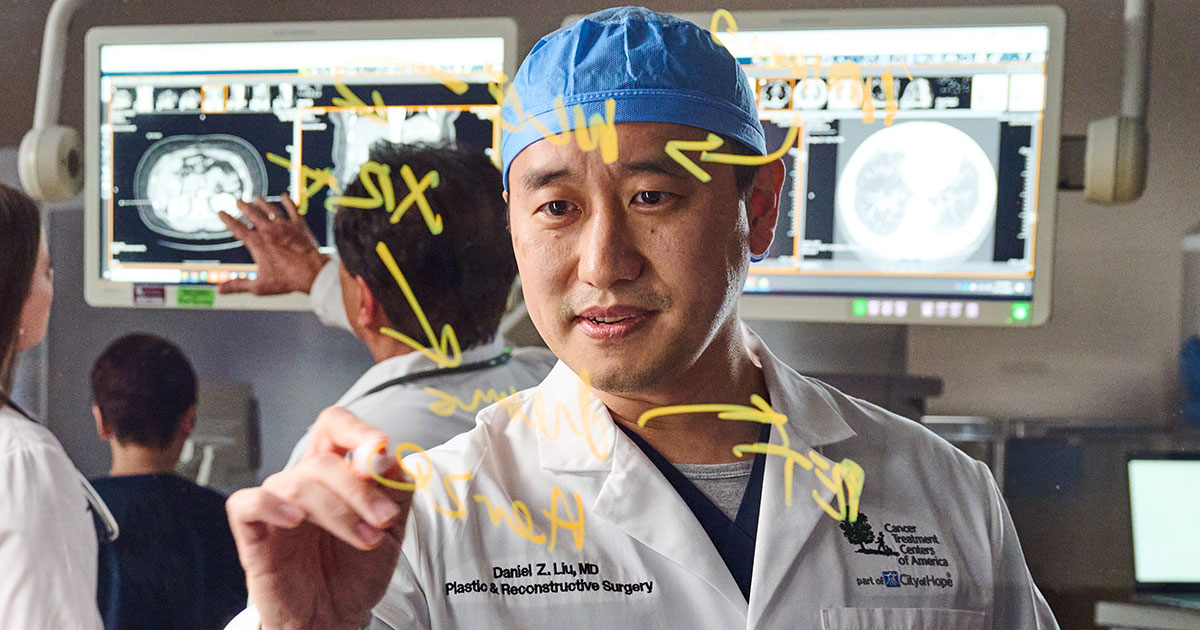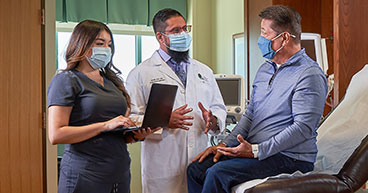
A swollen, red rash on the breast may be uncomfortable and alarming, especially in women concerned about a cancer diagnosis. However, this type of condition is not necessarily a breast cancer skin rash. Red, inflammatory rashes may stem from a variety of issues, including mastitis, breast abscesses, and mammary duct ectasia.
This article will explore inflammatory breast cancer and other types of skin conditions of the breast. Topics include:
- What is inflammatory breast cancer?
- What are the symptoms of inflammatory breast cancer?
- What is mastitis?
- What are the symptoms of mastitis?
- What is a breast abscess?
- What are the symptoms of a breast abscess?
- What is Paget’s disease?
- What are the symptoms of Paget’s disease?
- What is mammary duct ectasia?
- What are the symptoms of mammary duct ectasia?
- Inflammatory breast cancer rash vs. infection
If you believe you may be experiencing symptoms of breast cancer and want to schedule an appointment for diagnostic testing, or if you’re interested in a second opinion for breast cancer, call us or chat online with a member of our team.
What is inflammatory breast cancer?
When someone has a rash on the skin of the breast, their care team should consider a breast cancer rash as a potential cause. However, in reality, inflammatory breast cancer is very rare. Only 1 to 5 percent of the breast cancers diagnosed in the United States each year are inflammatory breast cancers. This type of cancer develops when the lymph vessels in the breast skin become blocked with cancer cells, usually invasive ductal carcinoma cells. This type of cancer is sometimes aggressive, and it may progress quickly. In about one in every three cases, inflammatory breast cancer is metastatic at the time of diagnosis.
Inflammatory breast cancer has certain characteristics that distinguish it from other types of breast cancer, according to the American Cancer Society. It may be more difficult to diagnose because it often doesn’t have an associated breast lump, which means it may not be detected via a traditional mammogram or breast ultrasound.
Inflammatory breast cancer is also unique among breast cancers in that it tends to develop in different demographic groups than traditional breast cancers. It is more likely to affect women who are younger than 40 years old, and black women. Inflammatory breast cancer is diagnosed using an imaging test (like an ultrasound or MRI), a biopsy (a sample of the affected breast tissue) or both. Identifying appropriate treatments for inflammatory breast cancer depends on various factors, including how far the cancer has spread. Types of treatments include chemotherapy, radiation therapy, surgery, targeted therapy or hormone therapy. Sometimes inflammatory breast cancer patients are initially misdiagnosed as having an infection and treated with antibiotics because breast skin infections are far more common than new inflammatory breast cancer diagnoses.
What are the symptoms of inflammatory breast cancer?
The symptoms of inflammatory breast cancer may develop quickly over three to six months. Symptoms may include:
- Peau d’orange, which means that the breast skin is pitted and resembles an orange peel.
- Breast tissue swelling.
- Redness of the breast skin (usually affecting more than a third of the breast tissue)
- Nipple swelling.
- An increase in breast size.
- Feelings of breast tenderness.
- Burning or heaviness.
- Lymph node swelling in the armpits or around the collarbone
What is mastitis?
Mastitis refers to inflammation of the breast tissue, usually caused by a bacterial infection. Mastitis is most commonly experienced by breastfeeding women when a milk duct becomes clogged and then inflamed and infected. However, other types of non-lactational mastitis may occur, in both women and men. Doctors usually prescribe antibiotics, typically up to 10 days, to treat mastitis. Breastfeeding women are also typically counseled to continue nursing or pumping to help clear the infection. Over-the-counter medications such as ibuprofen or acetaminophen and applying warm compresses may help control pain.
What are the symptoms of mastitis?
The symptoms of mastitis include swelling or pain of the breast tissue, skin redness and warmth of the affected area. These symptoms may mimic the symptoms of inflammatory breast cancer, but mastitis is a far more common condition. Because it’s typically caused by an infection, mastitis may trigger other symptoms such as body aches, fevers, chills, fatigue, headaches or flu-like symptoms.
What is a breast abscess?
A breast abscess refers to a collection of pus-like fluid within the breast tissue. This pocket of fluid may feel like a hard lump, or it may feel like it’s more mobile or “fluctuant” when touched. A breast abscess may develop as a complication of a breast infection, such as mastitis. Up to 11 percent of breastfeeding women with mastitis eventually develop a breast abscess.
Lactation-associated abscesses are more likely to occur within the first month of delivery (when both a nursing mother and an infant are getting accustomed to the process of nursing), during the process of weaning (when the breasts are more likely to be engorged), or when a nursing infant’s teeth develop and are more likely to cause trauma to the nipple. Other than lactation, risk factors that increase the likelihood of a breast abscess include having diabetes, being obese or smoking cigarettes. Breast abscesses are typically treated by removing the pus via an incision and drainage or through a small needle. Antibiotics and warm compresses may also be recommended.
What are the symptoms of a breast abscess?
A breast abscess is often painful. The buildup of pus may cause swelling of the breast tissue, redness of the surrounding skin and drainage. Because an abscess is an infection, other symptoms may also include fever, nausea vomiting and lymph node swelling in the armpits.
What is Paget’s disease?
Paget’s disease, or Paget's disease of the breast, is a rare subtype of breast cancer that involves the nipple and the surrounding skin, known as the areola. Only 1-4 percent of breast cancers are diagnosed as Paget’s disease. Medical scientists are not sure whether Paget’s disease is a cancer of the nipple itself or whether it develops when cancer cells spread from a tumor in another area of the breast. Most Paget’s disease patients have another form of breast cancer called ductal carcinoma in situ (DCIS). This is an early, non-invasive form of cancer, meaning that the cancer cells have not spread outside the breast. Identifying appropriate treatment options for Paget’s disease depends on other findings (such as other breast tumors). Typically, options include mastectomy or breast-conserving surgery with radiation therapy.
What are the symptoms of Paget’s disease?
Paget’s disease may cause irritation of the breast skin. It sometimes masquerades as other skin conditions involving breast skin, so it’s common for it to be misdiagnosed at first. With Paget’s disease, there may be itching or tingling of the nipple or surrounding areola. Symptoms may also include redness, crustiness, flakiness or skin thickening of the nipple and surrounding area that may resemble eczema of the nipple. Patients also may notice a flattened or inverted nipple, as well as bloody or yellowish discharge of the nipple.
What is mammary duct ectasia?
Mammary duct ectasia is a benign (non-cancerous) condition that may affect the appearance of the breast. It’s also known simply as duct ectasia or periductal mastitis. Mammary duct ectasia occurs when inflammation in the breast causes a milk duct to widen and thicken. These inflammatory changes may cause the milk duct to become blocked. Women who are nearing menopause are most likely to get mammary duct ectasia. However, people of any age, including post-menopausal women, may develop the condition. Treatment for mammary duct ectasia may include antibiotics, but it often resolves on its own.
What are the symptoms of mammary duct ectasia?
Some women with mammary duct ectasia experience no symptoms. When symptoms do develop from mammary duct ectasia, they may include tenderness or pain of the breast, redness of the skin of the breast, an inverted nipple or black or green nipple discharge. Some women also have a lump that forms due to the scar tissue that builds around the milk duct inflammation. This benign lump may be mistaken for cancer.
Inflammatory breast cancer rash vs. breast infection
Many breast conditions have overlapping symptoms. This is true of inflammatory breast cancer and breast infection conditions like mastitis, breast abscesses and mammary duct ectasia. It may be difficult to distinguish between the signs and symptoms of these conditions, especially in their early stages. That’s why it’s important to see a doctor for a thorough examination of any breast skin rash. Only a trained physician can diagnose one of these conditions.
If you believe you may be experiencing symptoms of breast cancer and want to schedule an appointment for diagnostic testing, or if you’re interested in a second opinion for breast cancer, call us or chat online with a member of our team.


